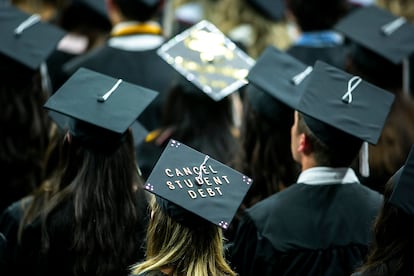The Trump Administration introduces new changes to student loans

After a five-year hiatus that began during the COVID-19 pandemic, federal student loan collections officially resumed on May 5. For millions of Americans, this marks not only the return of financial obligations, but the beginning of a significant transformation in how student loans are managed, repaid, and forgiven under the Trump administration.
The end of the pauseStudent loan payments were first suspended in March 2020 as part of pandemic relief efforts under the CARES Act. The Biden administration extended the pause several times, while introducing new forgiveness programs and more flexible repayment options. But with Trump back in office, many of those policies have been reversed.
Since May 5, delinquent borrowers—those who haven't made a payment in more than 270 days—are once again subject to aggressive collection tactics. The Department of Education , through a Treasury Department program, can now garnish wages, seize tax refunds, and reduce Social Security and disability benefits. According to the credit agency TransUnion, more than 20% of loans were more than 90 days past due in February 2025, nearly double the pre-pandemic rate.
Who does it affect?Approximately 43 million Americans have federal student loans, and the total outstanding balance is estimated at $1.693 trillion. The average borrower owes about $38,375. While many had hoped for continued relief or forgiveness, the Trump administration has taken a starkly different approach.
“American taxpayers will no longer be forced to serve as collateral for irresponsible student loan policies,” said Education Secretary Linda McMahon, referring to Biden-era initiatives. The administration has accused the previous administration of misleading borrowers about the federal government’s legal authority to cancel debt.

The most drastic change is not only in the enforcement of collections, but in the entire structure of the federal student loan system. Republicans in Congress, backed by Trump, have introduced a reform plan called the Student Success and Taxpayer Savings Plan, which will take effect on July 1, 2026.
The plan would reduce the current dozen repayment options to just two: a standard fixed-repayment plan and a new income-based plan called the Repayment Assistance Plan (RAP). Under the RAP, borrowers' monthly payments would range from 1% to 10% of their income. While the plan offers a $50 discount per child to parents and waives interest on some payments, it would extend the loan forgiveness period to 30 years and eliminate current protections that exempt a portion of income from repayment calculations.
Furthermore, unlike the Biden-era SAVE plan and previous IDR programs, the new GOP model would not offer early forgiveness and explicitly eliminates provisions that allowed certain defense workers and nonprofit employees to qualify for Public Service Loan Forgiveness (PSLF).
The Department of EducationMeanwhile, Trump has signed an executive order dissolving the Department of Education. Although its complete elimination would require an act of Congress, for now, most of its appropriations are being transferred. Student loan management will be transferred to the Small Business Administration (SBA), while special education and nutrition programs will be transferred to the Department of Health and Human Services (HHS). This comes despite a 40% staff cut at the SBA, raising questions about its ability to handle the large amount of money it handles.

The restructuring has drawn sharp criticism from education experts and disability advocates, particularly in response to the assignment of roles within HHS to controversial figures such as Robert Kennedy Jr.
Borrowers have also expressed concern about the growing dysfunction within the system. Earlier this year, the Department of Education eliminated online applications for the most popular repayment plans, including income-driven repayment (IDR) and federal loan consolidation. Although these services were eventually restored, the disruption left millions of people in limbo.
Similarly, hundreds of Federal Student Aid (FSA) employees were laid off, further delaying communication with borrowers and processing applications.
Programs reduced, not eliminatedDespite the cuts and policy changes, some avenues for debt forgiveness remain. PSLF remains in effect, but now excludes nonprofit employees engaged in “activism” or “improper” activities, according to a recent executive order. Teacher loan forgiveness remains available to eligible educators at low-income schools, offering up to $17,500 in debt relief.
The Biden-era SAVE plan , which caps monthly payments based on income and forgives balances after 10 to 20 years for some borrowers, is technically still active. However, its future is uncertain given Trump's opposition to broad debt relief.
Programs such as Total and Permanent Disability (TPD) Discharge, which provides forgiveness for borrowers with certified disabilities, have also not been affected so far.
EL PAÍS




%3Aformat(jpg)%3Aquality(99)%3Awatermark(f.elconfidencial.com%2Ffile%2Fbae%2Feea%2Ffde%2Fbaeeeafde1b3229287b0c008f7602058.png%2C0%2C275%2C1)%2Ff.elconfidencial.com%2Foriginal%2F6dc%2F163%2F2c2%2F6dc1632c25c527ac16308c121566efbd.jpg&w=3840&q=100)
